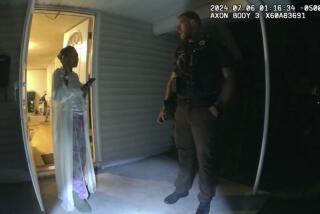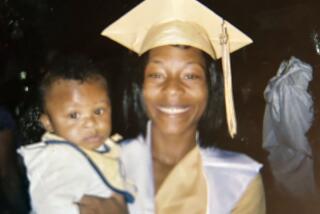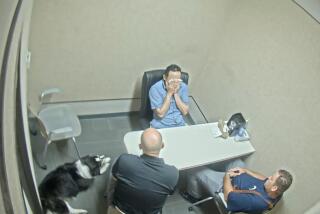‘I’m Sorry for Putting You Guys Out’ : Police: Simpson collapsed in officers’ arms. Details of bizarre day are revealed.
When it was all over, O.J. Simpson turned to the Los Angeles police officers who had talked him into giving up, and he calmly, quietly apologized.
“I’m sorry for putting you guys out,” said a drawn and haggard Simpson, whose flight from justice transfixed an anxious nation Friday night. “I’m sorry for making you do this.”
According to Los Angeles Police Department Special Weapons and Tactics officers who brought the pursuit to its successful conclusion at Simpson’s Brentwood home, Simpson shook a few hands and belatedly turned himself over to detectives.
“It was quite a moment,” said Sgt. Charles L. Duke, a senior member of the SWAT team and former college football player for the University of Arizona who once met Simpson on the gridiron. “Quite an evening.”
As he walked to the waiting police car, Simpson was escorted, at his request, by SWAT Officer Pete Weireter, a chiseled 17-year-veteran who spent 50 tense minutes talking with Simpson over a cellular phone as helicopters buzzed overhead and the world-famous athlete sat alone in his best friend’s car, cradling two pictures of his family, a rosary and a gun.
Simpson was confused and frightened in those conversations, officers said, but eventually agreed to come inside when he was promised that he could use the bathroom, have something to drink and call his mother.
He did, and less than an hour later, Simpson was booked on two counts of first-degree murder at Downtown police headquarters.
Here, based on interviews with key participants in the apprehension of Simpson, is an inside look at the most spectacular pursuit in Los Angeles police history.
The hunt began around noon, when LAPD officers made the shocking discovery that Simpson had fled the San Fernando Valley home where he was said to have been meeting with his doctors in advance of turning himself in on charges that he murdered his ex-wife and a male friend of hers.
News of Simpson’s disappearance rocked the upper reaches of the LAPD, which had expected the Hall of Famer to surrender around 11 a.m. at police headquarters. Told that their suspect was, as police say, “in the wind,” they scrambled to contain the damage and to recover their famous fugitive.
The first calls went to local law enforcement agencies--the Los Angeles County Sheriff’s Department and neighboring police departments. The U.S. Border Patrol was alerted, a warning that had special significance because no one had ever taken Simpson’s passport from him. Airlines, customs officials, the Mexican Judicial Police and other agencies were warned to be on the lookout for Simpson and his good friend and former teammate, Al Cowlings, with whom Simpson had last been seen.
Universally, the response was positive, officials said.
“Very responsive, very cooperative,” said Cmdr. David J. Gascon. “The spirit of cooperation and support was outstanding.”
With officers and agents fanning out across the region, scores of anonymous phone calls poured into the LAPD. Callers had tips about property that Simpson owned, about places that some people thought he might be headed. Some tips seemed better than others. Officers were dispatched to check out ones that seemed valid.
At 2 p.m., the LAPD received a 911 call to respond to the same condominium where Nicole Brown Simpson and her friend Ronald Lyle Goldman were brutally stabbed to death Sunday night. When they got there, Nicole Simpson’s father told police that a man identifying himself as Simpson had called at least twice and had said he was on his way over to kill himself.
The sight of grim-faced detectives entering Nicole Simpson’s home for the second time in less than a week was broadcast live. A few minutes later, police emerged to announce that Simpson was not in the house. “This is a false alarm,” Sgt. Doug Abney told the hundreds of reporters and neighbors who had flocked to the street outside the condominium.
For the next four hours, with the eyes of Southern California peeled for the missing athlete, top officials from the LAPD gathered in the cluttered third-floor squad room of the department’s Robbery-Homicide Division. Phones rang off the hook, officials consulted with each other and other agencies, detectives who worked the murder case were pressed into service to find a missing suspect. The hubbub in the room grew and grew, officials who were present said. Gascon described it as “controlled and purposeful chaos.”
An all-points bulletin had been issued for Cowlings’ car, a two-door Ford Bronco, but hours went by without a sighting.
Then, at 6:25 p.m., according to the California Highway Patrol, Chris Thomas and Kathy Ferrigno, a young couple on their way to go camping, made what the CHP calls the first verified sighting of the car. They got a good, long look at the driver, who, they told police, scowled back at them.
“We looked at him, you know, and he like stared us down, like he was death,” Thomas told police, according to a copy of the 911 tape released Saturday by the CHP.
Just minutes later, Orange County Sheriff’s Deputy Larry Pool saw a car that matched the all-points bulletin. It was heading north on Interstate 5 near the El Toro interchange.
Pool got close enough to read the license plate, a California plate numbered 3DHY503. When it checked out, the chase was on.
“It was simply a case of a deputy spotting the suspect vehicle, calling it in and doing what he’s trained to do,” said Lt. Ron Wilkerson of the Orange County Sheriff’s Department.
Sheriff’s deputies led the pursuit as it wound its way along the Santa Ana and Artesia freeways. Television news crews quickly picked up the chase, following every step of it as Cowlings snaked the Bronco through traffic. Before long, hundreds of Simpson admirers packed overpasses, waving signs and urging him on.
For LAPD commanders, the situation grew increasingly difficult to manage as the pursuit attracted ever-growing interest. Highway Patrol and the Orange County Sheriff’s Department were trailing the vehicle, with Simpson reportedly in the back seat, holding a gun to his head. News helicopters and police helicopters were overhead, and officials worried about the possibility of a crash. The gawkers who lined overpasses and roadways created still more hazards.
Cowlings, meanwhile, called 911 himself, pleading with authorities to back off and let Simpson see his mother.
“This is A.C.,” an agitated Cowlings told the 911 dispatcher. “I have O.J. in the car. Right now, we’re all, we’re OK. But you got to tell the police to just back off. He’s still alive, but he’s got a gun to his head.
“He just wants to see his mother,” Cowlings added. “Let me get back to the house.”
Police made no attempt to force the car over but followed close behind, lights flashing, as Cowlings piloted the Bronco back to Brentwood.
The chase slowly worked its way back over the county line to Los Angeles, and that meant handing off sheriff’s functions to the LAPD. That, too, required coordination, all of it funneled through the 15 to 30 police officers hunkered down in the LAPD command center.
At about 7:15 p.m., Detective Tom Lange, one of the lead investigators in the murder investigation, managed to reach Simpson in the car. For the next 40 minutes or so, Lange talked off and on with Simpson, trying to calm him and persuade him not to hurt himself.
It was a frustrating process. The cellular phone went dead a couple of times, and Simpson, who spoke of wanting to see his mother, would hang up occasionally. But Lange kept after him, reminding Simpson of friends and family who cared about him and depended on him.
Although police credited Lange with an exemplary job of cooling off a volatile situation, negotiations were handed over to SWAT officers once Simpson and Cowlings pulled into Simpson’s Brentwood home. There, with a spellbound nation watching on live television, the final act of the riveting drama was played out.
SWAT officers had only been at the mansion for about 15 minutes when Cowlings and Simpson rolled past the horde of news crews and up the cobblestone driveway. That barely gave them time to craft a strategy, and they had little idea what to expect. Was Simpson coming home to surrender? Or was he returning to die?
“We had hurry-up offense,” said Sgt. Mike Albanese, a SWAT supervisor who oversaw the negotiations. “We were moving full speed.”
Simpson friend Bob Kardashian was at the house, but police had evacuated everyone else--at least, they thought they had until Simpson’s eldest son, Jason, came bounding up to the car just as it came to a stop.
He grabbed at the door handle, and Cowlings roughly pushed him back. The two men exchanged words in the driveway, just a few feet away from Simpson.
“We’re looking at each other wondering: ‘Can this thing get any crazier?’ ” Albanese said.
Officers eventually pulled Simpson’s son away from the scene, but Cowlings remained angry and frantic. “He’s yelling at us that he’s (Simpson’s) got a gun,” Albanese said. “He’s saying: ‘Don’t do anything stupid. Get the police away.’ ”
Police refused to back off and already had decided that under no circumstances would Cowlings and Simpson be allowed to leave again in the car. One way or another, the long day was going to end in Brentwood.
At the same time, police were reluctant to arrest Cowlings in front of Simpson, Albanese said, for fear that the sight of his close friend being taken into custody might push Simpson to commit suicide as he was threatening.
Instead, officers coaxed Cowlings indoors and tried to calm him down. After about 20 minutes, Cowlings seemed less agitated and, in fact, managed to help police through a technological glitch in their negotiations with Simpson. Midway through Officer Weireter’s discussions with the star, Simpson’s cellular phone battery died.
With the helicopters buzzing overhead, it was next to impossible to talk face to face--an approach that SWAT generally avoids in any case, in part because it exposes officers to danger if a suspect should decide to go down shooting.
Cowlings got the police over that hurdle by delivering Simpson a fresh cellular phone. That allowed the talks to continue, and Simpson rushed to reassure the officers that he meant them no harm.
“He made a comment that he had a gun in the car, but he wanted to hurt himself,” Albanese said. “He didn’t want to hurt us.”
Weireter, an experienced negotiator, thanked Simpson for that assurance and urged him along, saying that police were glad he meant them no harm but that they also wanted to be sure that he came through unhurt. “Our job out there is to resolve this peacefully, with no harm to him or to anyone else, regardless of what he may or may not have done,” Albanese said.
As they talked, Simpson would cradle the family pictures, sometimes hugging them to his chest, other times resting his head on them, Albanese said.
Eventually, Simpson agreed to come out of the car unarmed, provided that police agreed to three things: He wanted to go to the bathroom, he wanted a drink and he wanted to call his mother. Weireter agreed to all three, and a few minutes later, Simpson emerged from the car.
According to Albanese, Simpson first held up one of the family photographs, then the second, to show that he was not carrying a gun. He then walked across the small space between the car and the house, where he was greeted by the SWAT team.
“He literally collapsed in our arms,” Albanese said. “We had to take him and put him in a chair. From that point on, it was basically a non-event.”
Times staff writer Jeff Brazil contributed to this report.
More to Read
Sign up for Essential California
The most important California stories and recommendations in your inbox every morning.
You may occasionally receive promotional content from the Los Angeles Times.











